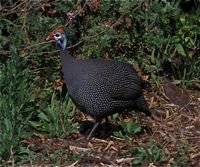KC Tsang was so impressed by the yellow wattles on the ear-coverts and nape of the Hill Myna (Gracula religiosa) (left) that he searched the web to find out their functions…
“Wattles are fleshy wrinkled folds of skin that hang from the cheeks, neck, throat… They are just skin that has no feathers on it. They can be found in a number of bird species, often brightly coloured, mainly red, yellow, pink or white, and are believed to be used in courtship and aggressive displays.”
Gill (2007) reports that wattles help to maintain the temperature of the bird’s brain to about 1ºC cooler than that of the body. This is because the heat generated during flight can cause an increase in body temperature that can be damaging to the bird. Thus some species of birds do not fly at temperatures above 35ºC because of their inability to control hyperthermia. Others fly only short distances.
In Helmeted Guineafowl (Numida meleagris) (right), the naked head has a large protrusion or helmet and wattle that enhance heat loss. Heat loss may thus be so great that the guineafowl’s head cools faster than its body, well beyond the ability of increased blood flow from the body to replace the loss of heat.
The wattles of the chicken and turkeys may well have similar functions. As with the Hill Myna’s.
Image of Hill Myne by KC Tsang; that of Helmeted Guineafowl by YC.
Reference:
Gill, F. B., 2007. Ornithology. W. H. Freeman & Co., New York. 758 pp.











2 Responses
That’s interesting. Would it have a display function as well? Seeing the colour
Sure it does.